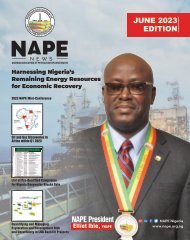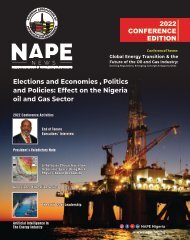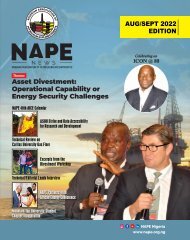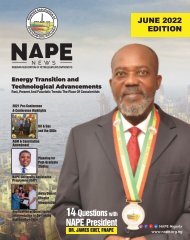NAPENews Magazine August 2021 Edition
NAPE News Magazine August 2021 Edition of the NAPE News is here for your reading pleasure. Happy reading.
NAPE News Magazine August 2021 Edition of the NAPE News is here for your reading pleasure. Happy reading.
Create successful ePaper yourself
Turn your PDF publications into a flip-book with our unique Google optimized e-Paper software.
Technical Article
MERITS AND LIMITATIONS OF ARTIFICIAL
INTELLIGENCE IN SUBSURFACE EVALUATION
INTRODUCTION
Over the years, exploration activities for
commercial quantity of oil and gas
deposits which covers; acquisition of
the necessary subsurface data,
interpretation, and evaluation of these
data have benefited largely from
increasing technological advancement.
T h i s h a s r e s u l t e d i n b e t t e r
understanding of the subsurface
(improved imaging of the subsurface for
better interpretation and further
decision making), which has then led to
the discovery of more commercial
deposits of oil and gas resources for
exploration and production companies,
since the 1980's when the industry
embraced digital technologies to drive
greater efficiencies.
Artificial intelligence (AI) – a term
invented by John McCarthy in 1950,
which entails the simulation of human
intelligence in machines that are
programmed to think like humans and
mimic their actions. Just as human
intelligence isn't in a single dimension,
AI is equally varied and structured in a
similar manner; as it is simply many
advanced technologies (deep learning
(DL) - a subfield of machine learning
and machine learning (ML) - a subfield
of artificial intelligence, Figure 1)
brought together to enable a machine to
act with human-like levels of
intelligence. Hence, providing context
and meaning to the information it learns,
Fig. 1. Venn diagram showing the relationship
between diversified fields of Artificial Intelligence
(AI) and Machine Learning (ML), Deep
Learning (DL) (Sircar et al., 2021).
The subsurface evaluation arm of the oil and gas industry, not left behind has also
been greatly impacted by technological advancements, particularly AI which is of
concern here. Some of the merits (Figure 2) AI has brought to the task of evaluating
the subsurface are highlighted below;
Fig. 2.Geoteric's AI assisted fault interpretation enables the delineation of faults at multiple
scales in a region of interest; from regional faulting to smaller scale faults that could
have an impact on prospectivity and production (Brownless, 2020).
Merits of AI in Subsurface Evaluation
l AI has brought about the
identification of events quicker and
with a greater level of accuracy. It
can see beyond false signals which
give unclear or disappointing
results in traditional fault detection
attribute analysis.
l AI and ML have been used to
identify facies and bedding
structures and upscale plug
measurements to the entire core
section.
l It has also been applied in
generating high-resolution estimate
of rock properties in a fraction of the
time of conventional methods.
l It has contributed to increasing
the efficiency in optimising
subsurface data analysis for
exploration and production.
l Better interpretations of
subsurface images from seismic
studies using computer vision
technology have been obtained.
l Technical documents are also
being analysed using natural
language processing (NLP), hence,
m a k i n g e x p l o r a t i o n a n d
assessment of oil and gas fields
faster and more effective.
Limitations of AI in Subsurface
Evaluation
l Although, the oil and gas
industry is readily saturated with a
lot of data, however, the application
of AI is limited by the quality and
accuracy of data with which the
technology is trained with; to
prevent amplifying existing human
mistakes. Hence, quality data must
be provided in implementing AI in
subsurface evaluation, which can
be challenging.
l It is limited by its inability to
think out of the box, as is expected
of an interpreter at the workstation.
l It largely depends on the domain
expert's workflow, with which it is
trained for the task it is to carry out.
By Adewale Sadiq,
Cypher Cresent
NAPENEWS AUGUST 2021 55










